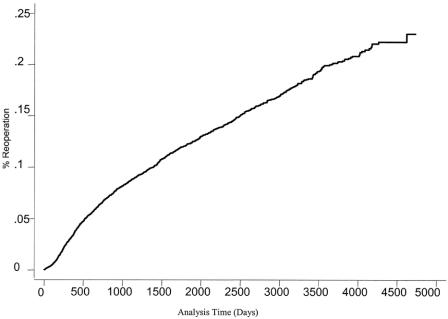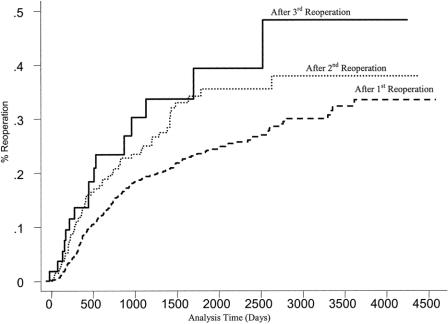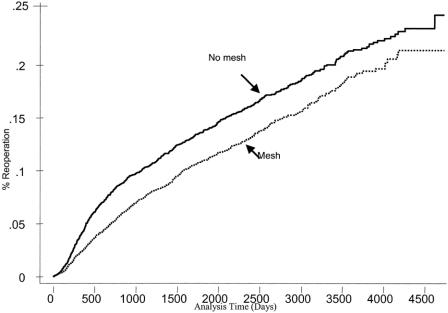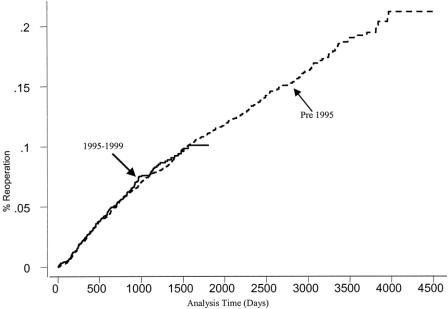Abstract
Objective
To determine if certain outcomes of incisional hernia repair have improved in recent eras.
Summary Background Data
Technological developments have been reported to improve outcomes in the repair of abdominal wall incisional hernias.
Methods
This retrospective, population-based cohort study was conducted using a 1987 to 1999 Washington hospital discharge database. Subjects were all Washington state residents assigned ICD9 procedure codes for incisional hernia repair with or without synthetic material (mesh). Main outcome measure was the rate of reoperative incisional hernia repair, length of hospitalization, and hospital charges based on the use of synthetic material and the era of operative repair (before and after 1995).
Results
A total of 10,822 Washington state patients underwent incisional hernia repair (mean age 58.7 ± 15.6, 64% female). Of patients undergoing incisional hernia repair, 12.3% underwent at least one subsequent reoperative incisional hernia repair within the first 5 years after initial repair (23.1% at 13 years follow-up). The 5-year reoperative rate was 23.8% after the first reoperation, 35.3% after the second, and 38.7% after the third. The use of synthetic mesh in incisional hernia repairs increased from 34.2% in 1987 to 65.5% in 1999. When controlling for age, sex, comorbidity index of the patient, year of the initial procedure, and hospital descriptors (rural location, nonprofit and teaching status), the hazard for recurrence was 24.1% higher if no mesh was used compared to the hazard if mesh was used. After similar adjustment, no differences were found in the hazard of reoperation based on the era of the operative repair. Mean length of stay for procedures performed after 1995 was 4.9 days compared to 4.8 days in preceding eras.
Conclusions
Incisional hernia repair is associated with high cumulative rates of reoperative repairs. The expectation that important measures of adverse outcome have improved in recent eras is not supported by the results of this large population-based study.
More than 10% of patients undergoing abdominal surgical procedures develop incisional hernias. 1 This suggests that of the over 1.3 million laparotomies performed last year in the United States, 2 at least 153,000 patients are likely to develop such hernias, more than a third of which are expected to be symptomatic. 1 The burden of incisional hernias varies widely but primarily includes pain at the site of the hernia and limitations of activity. Intestinal obstruction, skin ulceration, and even death due to compromise of the intestinal blood supply have also been reported. Both laparoscopic and open surgical approaches exist to repair incisional hernias, with a lack of consensus regarding the best approach. 3 Both types of repairs hold the risk of hernia recurrence, 4 infectious complications, 5 and prolonged hospitalization. 6
Recurrence of the hernia is among the more problematic adverse outcomes following incisional hernia repair, 1,7 with progressively higher rates of recurrence after repeated repair. 7,8 The community-level risk of recurrence has not been well assessed. Furthermore, while several prospective 9 and retrospective 10 series have suggested that laparoscopic repairs have a favorable impact on the rate of recurrence and length of hospitalization, 8–12 no randomized trial has effectively compared open and laparoscopic approaches.
Population-based research is an important adjunct to outcomes assessment because by studying large communities of patients, the population frequency of adverse outcome can be determined. Monitoring such rates over time may be an effective way to assess the impact of developing technology and changes in practice patterns. In the absence of such data, it is difficult to determine the anticipated community-level impact of new surgical techniques. This study seeks to define the temporal trends and outcomes following incisional hernia repair in a statewide population and to determine if recurrence and length of hospitalization after incisional hernia have decreased in more recent eras.
METHODS
Study Design
A retrospective cohort study was conducted using a statewide, population-based hospital discharge database. Data were obtained from the Washington State Comprehensive Hospital Abstract Reporting System (CHARS) database. This dataset is derived from all public and private hospitals in Washington state, excluding Veterans Affairs (VA) and U.S. military hospitals. Error due to missing VA and military hospital patients was recognized but assumed to be stable over time. The dataset contains demographic variables, admission and discharge administrative details, payer status, ICD9 procedure and diagnosis codes, and coded hospital identifiers. CHARS records of interest were linked to the Washington State Department of Health Vital Statistics Database to identify patients who died during the follow-up period. While the linkage of these two datasets was performed with coded patient identifiers, an anonymous dataset was used for the analysis. U.S. census bureau data for yearly state population estimates were used for population-based analyses.
This study was exempted from human subjects review by agreement of the University of Washington Human Subject Review Committee and the Washington State Department of Health. The dataset included anonymous data and is considered within the public domain.
Subjects
The cohort was defined by searching all CHARS reports (1987–1999) for ICD9 procedure codes pertaining to incisional abdominal wall hernia with and without the use of synthetic material (5351, incisional hernia repair, no mesh; 5361, incisional hernia repair, mesh).
The cohort of patients undergoing incisional hernia repair was followed in time longitudinally using coded patient identifiers. Subsequent hospitalizations for the same ICD9 procedure codes were considered reoperative events. Records that had the procedure code “hernia repair with synthetic material” were defined as mesh repairs. No ICD9 procedure code exists for laparoscopic incisional hernia repair. To consider reoperative rates during different time periods of interest, we defined two distinct eras for evaluation (1987–1994 and 1995–1999). The first laparoscopic incisional hernia repair was reported in 1993, 13 so considering that it might take at least 1 year for diffusion of the technique, only the later era was considered to have a high likelihood of including laparoscopic procedures. Because it is possible that some laparoscopic techniques occurred before 1995, we first separated the cohort into three groups (pre-1990, 1991–1994, and post-1995) and compared only the pre-1990 and post-1995 groups. This did not affect overall results, so we used the pre- and post-1995 breakpoint for the remainder of the analysis. To adjust for potential confounding, a comorbidity index (0–3, with 3 indicating greatest comorbidity) was calculated for each patient based on ICD9 diagnostic codes. 14
Statistical Analysis
To assess temporal trends in the management of incisional hernia, we first calculated yearly population-based frequencies of incisional hernia repairs. Population-based rates are reported as cases per 10,000 person-years. Poisson regression was used to test for a significant change over time in the rate of incisional hernia repair.
Differences between patients who did or did not undergo reoperative hernia repair were compared using the Pearson chi-square statistics for categorical variables and the Student t test for continuous variables. Hospital charges were adjusted for inflation using the Consumer Price Index yearly adjustment for healthcare in the Western region.
Mesh use and the era of initial operative repair were related to reoperation over time using univariate and multivariate Cox proportional hazard regression analyses. The median follow-up was 3.9 years, with 75% of patients followed up for 7.1 years or less. Reoperation-free time was measured as the time from initial operation until reoperation, death, or December 31, 1999. The proportional hazards assumption was confirmed by inspection of Schoenfeld residuals and log-log plotting. Cox regression was used to simultaneously estimate the effect of potential confounders and the association of mesh and the era that the procedure was performed on the hazard of reoperative repair.
To estimate the probability of reoperative events over time, Kaplan-Meier curves were constructed. The cumulative incidence of reoperative incisional hernia repair was estimated (1 - survivor function) for the entire cohort and then tested between groups of interest (mesh and nonmesh, pre-1995 and post-1995 eras). Unadjusted analyses were compared using the log-rank test. Statistical analysis was performed using STATA statistical analysis software (STATA Corp., College Station, TX).
RESULTS
Between 1987 and 1999, 10,822 Washington state patients underwent incisional hernia repair (mean age 58.7 ± 15.6, 64% female). The incidence of the procedure per 10,000 in the state increased at an estimated rate of 3.6% per year (95% confidence interval [CI] 3.1–4.1%) (Fig. 1). Hospitalizations during which an incisional hernia was repaired averaged 4.85 ± 5.3 days, with adjusted median hospital charges of $7,972 (interquartile range $5,276–$12,516). Washington state hospital charges associated with incisional hernia repair in 1999 were approximately $11.4 million.

Figure 1. Population incidence of incisional hernia repairs in Washington state, 1987–1999.
Of patients undergoing incisional hernia repair, 12.3% underwent at least one subsequent reoperative incisional hernia repair within the first 5 years after initial repair (Fig. 2) and 23.1% at nearly 13 years of follow-up. The length of reoperation-free time was progressively shorter after each incisional hernia repair (Fig. 3). The 5-year reoperative rate was 23.8% after the first reoperation, 35.3% after the second, and 38.7% after the third.
Figure 2. Progression to reoperative repair, all patients.
Figure 3. Rate of reoperation after each subsequent repair.
Patients undergoing reoperation differed slightly in their demographic characteristics from those who did not require reoperation (Table 1). Patients undergoing reoperation were more often female and younger and had a lower level of comorbidity than those who did not undergo reoperation. The rate of reoperation was similar in rural and urban hospitals (11.2 vs. 11.7%, P = .5), profit and nonprofit hospitals (12.7 vs. 11.2%, P = .2), and teaching and nonteaching hospitals (11.5 vs. 11.4, P = .9). Using proportional hazards, the only patient-level or hospital-level variable found to be significantly associated with reoperation was patient age: for each 1-year increase in age, the hazard of reoperation decreased by 2% (odds ratio 0.989, 95% CI 0.985–0.992).
Table 1.DEMOGRAPHIC FEATURES OF PATIENTS WITH AND WITHOUT RECURRENCE

The use of synthetic mesh in incisional hernia repairs increased dramatically, from 34.2% in 1987 to 65.5% in 1999. The use of mesh appeared to be an important feature in reoperation, with the rate of reoperation over time significantly higher for nonmesh operations (Fig. 4). During the first 5 years of follow-up, the cumulative reoperative rate was 13.9% when mesh was not used compared to 11% when it was used (log-rank differences in survival estimates, P < .001). The rate of reoperation after the fifth year increased at a similar rate regardless of mesh use. When controlling for age, sex, comorbidity index of the patient, year of the initial procedure, and hospital descriptors (rural location, nonprofit and teaching status), the hazard for recurrence was 24.1% higher if no mesh was used compared to the hazard if mesh was used (95% CI 10.2–39.9%).
Figure 4. Progression to reoperative repair, all patients, by use of mesh.
To account for changes in management of incisional hernia over time, Kaplan-Meier estimates of reoperation were generated based on the pre-1995 to post-1995 cohorts. No differences in the rate of reoperation were found based on the era in which the procedure was performed (log-rank differences for survival estimates, P = .6). To address the possible impact of laparoscopic repairs, we compared estimates of reoperation before and after 1995 for mesh repairs only (laparoscopic repairs are always performed with synthetic material). We found no differences in rates of reoperation based on this latest era of operative repair (Fig. 5), in both unadjusted models (log rank P = .6) and when controlling for the use of mesh, sex, age, and comorbidity index (hazard ratio 1.05, 95% CI 0.91–1.2).
Figure 5. Progression to reoperative repair, post-1995 vs. pre-1995.
To assess the possible impact of laparoscopic interventions, we also compared length of stay per year, anticipating shorter lengths of stay in later years when laparoscopic repairs might have had an impact. Mean length of stay following procedures performed after 1995 was 4.9 days compared to 4.8 days in preceding eras (P = .3). The inflation-adjusted mean charges for the procedure did increase with time, from $9,631 in 1987 to $13,282 in 1999 (P < .001), with an even greater increase in the rate of rise of charges in the late 1990s.
DISCUSSION
This report represents the first population-based evaluation of the reoperative course of patients undergoing incisional hernia repair and of temporal changes in the management of primary incisional hernia. We identified a 3.7% yearly increase in the incidence of initial incisional hernia repair per 10,000 people in the state. It is unclear if this growing rate of incisional hernia repair is the simple result of an increase in the frequency of abdominal procedures over time. Alternatively, it is possible that this reflects an increase in the rate of incisional hernia formation or of an increased willingness of patients to undergo repairs of their incisional hernias in more recent years. Minimally invasive approaches to incisional hernia became favored in the middle to late 1990s, and when laparoscopic approaches were developed for gallbladder disease, the number of patients undergoing cholecystectomy increased and was found to be related to a greater willingness of doctors to recommend (and patients to undergo) that procedure. 15
In this study, population-based approaches were used to quantify the frequency of reoperation after incisional hernia repair. The cumulative 5-year frequency of reoperation was 12.3%, with over 23% of patients undergoing reoperation by 13 years. Although a high rate of recurrence after incisional hernia repair has been documented by previous prospective and retrospective series, 1,7,8 most previous reports have suffered from one or more of the following biases: reduced sample sizes, single-institution experience, relatively shorter follow-up times, failure to account for censoring events such as death, and high rates of patients lost to follow-up. Because of the large number of patients analyzed in our study and the near-comprehensive assessment of surgical procedures performed in the state, we could more accurately quantify the cumulative frequency of incisional repair breakdown at any point in time during a cumulative 13-year follow-up period. However, even this study fails to capture reoperation in totality because repairs continue to occur even at the end of the follow-up period. Although it has been previously suggested that 85% of all breakdowns occur within 5 years of the initial surgery, 1 that estimate fails to account for the long time course required to determine the true cumulative frequency of hernia breakdown. Our findings reinforce the importance of at least 5-year follow-up time in comparing new techniques for hernia repair. In addition to the fact that more recurrences occur by 5 years than by 1 year, significant differences in the rate of breakdown were noted within the first 5 years of repairs based on repair type. To identify these subtle differences in rate of breakdown, 5-year follow-up is recommended. We also found progressively higher 5-year cumulative frequencies of reoperation after each subsequent repair (23.8%, 33.6%, and 38.7% reoperative frequency after the second, third, and fourth repairs, respectively).
During the time course of the study, there were important technical changes in the way incisional hernias were repaired. An increase in the frequency of synthetic mesh use (from 35% in 1987 to 65% by 1999) may reflect a growing consensus 3,16 that when possible, synthetic materials should be used in incisional hernia repair because of a lower rate of recurrence with mesh use. Our study demonstrated this lower rate of reoperation when mesh was used but found that this benefit was principally confined to the first 5 years of follow-up. This difference in 5-year cumulative frequency of reoperation with mesh use was modest but statistically significant (13.9% in nonmesh operations vs. 11% in mesh repairs). Because both increased mesh use and reoperation rates were time-dependent phenomena, a more complete estimate of the predicted benefit of mesh was found using Cox proportional hazards. Regardless of study year and patient and hospital features, the use of mesh was associated with a 24% decrease in the hazard of reoperative repair.
Temporal changes in the use of synthetic materials overlapped the growing availability of laparoscopic repairs during the second half of the 1990s. The first case series 13 describing laparoscopic abdominal wall hernia repair was published in 1993; it was technically an extension of inguinal hernia techniques. Although we cannot estimate what proportion of statewide procedures were performed laparoscopically (there is no ICD9 procedure code for laparoscopic incisional hernia repair), at the University of Washington Medical Center in 1996 no such repairs were performed but by 1999 51% of incisional hernia repair procedures were performed laparoscopically. The development of laparoscopic incisional hernia repair was intended to decrease the morbidity associated with open incisional hernia repairs and has been suggested to decrease the rate of hernia recurrence. 9–11 Our study demonstrated that in the prelaparoscopic era, the repair of an incisional wall hernia was associated with a hospital stay of close to 5 days, average hospital charges of greater than $5,000, and a high rate of reoperation. When we tried to identify the impact of laparoscopic repairs by comparing the post-1995 cohort undergoing mesh repairs to the patients undergoing mesh repairs in earlier eras, we found no significant differences in the rate of reoperation or length of stay. Because there is no ICD9 procedure code for laparoscopic incisional hernia repair, we can only speculate about the relationship of laparoscopic repairs and these findings. It may be that laparoscopic repairs are not being performed in Washington state often enough to have an impact on the mean length of hospitalization or rates of reoperation. Alternatively, these repairs may be performed often enough, but the results in the community at large may not be as good as those found in case series that reflect an individual surgeon’s best results. Lastly, laparoscopic repairs may be affecting these outcomes as anticipated, but features of patients or surgeons or unanticipated forces may be promoting reoperation and/or increases in the length of stay. We did find a significant increase in inflation-adjusted hospital charges during the study period (with the most rapid increases identified in the late 1990s), which might be consistent with increased use of laparoscopic technology. 17
This study has several limitations. Measuring the rate of reoperative hernia repair is not equivalent to determining the rate of hernia recurrence. A patient could have a recurrence and simply not have it repaired or have it repaired in another state. We believe that the rate of reoperation, however, reflects (if undercounts) recurrence and is likely to be a consistent and reasonable estimate of this adverse outcome. There is a potential element of confounding that could not be accounted for in this analysis. It may be that not all patients with a recurrence are equally willing to undergo a reoperation. Indeed, our initial demographic analysis indicated that patients undergoing reoperation were different than those not undergoing reoperation. Patients undergoing reoperation tended to be younger and more often female and had fewer comorbid illnesses. It may be that healthier and younger patients were more active and therefore had a higher rate of recurrence due to increased activity. Alternatively, these patients may have been more likely to undergo reoperation than older patients with a greater number of comorbid illnesses. It is unclear how this degree of confounding might have affected our findings that mesh repairs progressed to reoperation at a slower rate and that repairs in more recent eras were as likely to progress to reoperation as repairs from previous eras. Furthermore, we were limited in the way we could define patients undergoing index and reoperative procedures. It is unclear if a subsequent operation for an incisional hernia reflected a reoperation of a failed hernia repair or a new hernia in a different incision. In addition, index cases identified in the first year of available data may actually represent reoperative cases of index procedures performed in previous, unavailable years. Lastly, although we can define the rate of reoperation based on the era in which the procedure was performed, any assumptions about the reason why the rate of reoperation remained unchanged run the risk of ecologic fallacy.
This population-based study demonstrates the large financial and utilization burden associated with incisional hernia repair and the breakdown of these repairs over time. Incisional hernia repair is associated with high cumulative rates of reoperative repairs. To appropriately assess this adverse outcome, long follow-up periods (at least 5 years) are required. Most importantly, temporal changes in the management of incisional hernia repair (including the use of mesh and perhaps laparoscopic repairs) have not had an impact on the overall rate of reoperative repair. Further studies will be required to better assess the community-level impact of laparoscopic repairs on the rate of hernia recurrence, length of stay, and hospital charges. The expectation that important measures of adverse outcome have improved in recent eras is not supported by the results of this large population-based study.
Footnotes
Correspondence: David R. Flum, MD, Department of Surgery, Robert Wood Johnson Clinical Scholars Program, University of Washington, H-220 Health Sciences Center, Box 357183, Seattle WA 98195-7183.
E-mail: daveflum@u.washington.edu
Accepted for publication March 1, 2002.
References
- 1.Mudge M, Hughes LE. Incisional hernia: a 10-year prospective study of incidence and attitudes. Br J Surg 1985; 72: 70–71. [DOI] [PubMed] [Google Scholar]
- 2.http://www.cdc.gov/nchs/faststats/insurg.htm. Advanced Data No. 319, Table 8, April 24, 2001.
- 3.Korenkov M, Paul A, Sauerland S, et al. Classification and surgical treatment of incisional hernia. Results of an experts’ meeting. Langenbecks Arch Surg 2001; 386: 65–73. [DOI] [PubMed] [Google Scholar]
- 4.van der Linden FT, van Vroonhoven TJ. Long-term results after surgical correction of incisional hernia. Neth J Surg 1988; 40: 127–129. [PubMed] [Google Scholar]
- 5.Petersen S, Henke G, Freitag M, et al. Deep prosthesis infection in incisional hernia repair: predictive factors and clinical outcome. Eur J Surg 2001; 167: 453–457. [DOI] [PubMed] [Google Scholar]
- 6.Voeller GR, Ramshaw B, Park AE, et al. Incisional hernia. J Am Coll Surg 1999; 189: 635–637. [DOI] [PubMed] [Google Scholar]
- 7.Langer S, Christiansen J. Long-term results after incisional hernia repair. Acta Chir Scand 1985; 151: 217–219. [PubMed] [Google Scholar]
- 8.Costanza MJ, Heniford BT, Arca MJ, et al. Laparoscopic repair of recurrent ventral hernias. Am Surg 1998; 64: 1121–1127. [PubMed] [Google Scholar]
- 9.Heniford BT, Park A, Ramshaw BJ, et al. Laparoscopic ventral and incisional hernia repair in 407 patients. J Am Coll Surg 2000; 190: 645–650. [DOI] [PubMed] [Google Scholar]
- 10.Heniford BT, Ramshaw BJ. Laparoscopic ventral hernia repair: a report of 100 consecutive cases. Surg Endosc 2000; 14: 419–423. [DOI] [PubMed] [Google Scholar]
- 11.Park A, Gagner M, Pomp A. Laparoscopic repair of large incisional hernias. Surg Laparosc Endosc 1996; 6: 123–128. [PubMed] [Google Scholar]
- 12.Toy FK, Bailey RW, Carey S, et al. Prospective, multicenter study of laparoscopic ventral hernioplasty. Preliminary results. Surg Endosc 1998; 12: 955–959. [DOI] [PubMed] [Google Scholar]
- 13.LeBlanc KA, Booth WV. Laparoscopic repair of incisional abdominal hernias using expanded polytetrafluoroethylene: preliminary findings. Surg Laparosc Endosc 1993; 3: 39–41. [PubMed] [Google Scholar]
- 14.Deyo RA, Cherkin DC, Ciol MA. Adapting a clinical comorbidity index for use with ICD-9-CM administrative databases. J Clin Epidemiol 1992; 45: 613–619. [DOI] [PubMed] [Google Scholar]
- 15.Steinle EW, VanderMolen RL, Silbergleit A, et al. Impact of laparoscopic cholecystectomy on indications for surgical treatment of gallstones. Surg Endosc 1997; 11: 933–935. [DOI] [PubMed] [Google Scholar]
- 16.Luijendijk RW, Hop WC, van den Tol MP, et al. A comparison of suture repair with mesh repair for incisional hernia. N Engl J Med 2000; 343: 392–398. [DOI] [PubMed] [Google Scholar]
- 17.Greenberg D, Peiser JG, Peterburg Y, et al. Reimbursement policies, incentives and disincentives to perform laparoscopic surgery in Israel. Health Policy 2001; 56: 49–63. [DOI] [PubMed] [Google Scholar]






